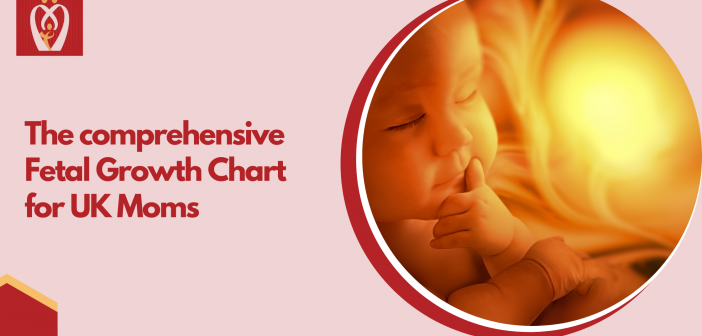Your belly will grow in size as your child grows within your womb during your pregnancy.
However, this will not give you an accurate picture of your baby’s size since he is surrounded by amniotic fluid. A baby’s typical weight and length are shown in the fetal growth chart below, which spans from eight weeks of pregnancy all the way to delivery.
In terms of foetal height and weight, what should I be aware of?
Eight to 19 weeks of pregnancy is the typical time frame for measuring a baby’s height and weight in the womb (also known as the “crown-to-rump length” or “CRL”).
During your 20-week anomaly scan, your baby will be more active, which means that the CRL is less reliable. As a result, your GP will measure your child’s head circumference, belly circumference, and femoral bone length (FL).
From eight weeks to 19 weeks, we use the CRL (head-to-bottom-length) chart, and thereafter we use crown-to-heel measures till delivery.
You should only be worried about your baby’s development if there is a deviation of more than two weeks up or down from the chart below for your stage of pregnancy. If this occurs, your GP will have you undergo further testing to confirm that your baby is healthy and that your pregnancy is proceeding normally.
During the course of my pregnancy, how frequently will the size of my unborn child be assessed?
During your pregnancy, you’ll have a series of scans to monitor the development of your unborn child.
When a woman is between six and nine weeks pregnant, she has a dating and viability scan. You’ll get a precise due date based on the baby’s crown-to-rump length (CRL).
Between the 11th and 13th weeks of pregnancy, the nuchal translucency scan is performed.
Between 18 and 20 weeks, the ultrasound level II abnormality scan is performed. In this scan, the GP will measure your baby’s head circumference, stomach circumference, and thigh bone length (femur) (FL). Your baby’s dimensions mean that the gestational age provided to each section of his or her body will be somewhat different from one another. All infants would be born at the same weight and height if they all grew in the same manner.
Between 28 and 32 weeks of pregnancy, you’ll get a growth scan or fetal well-being scan.
What is the fundal height, and how can my GP use it to monitor my baby’s growth?
Fundal height is a measurement of how far the tip of your womb has advanced in your abdomen between scans.
It’s impossible to tell exactly how big your kid is from this, but it will warn your GP if he or she isn’t developing as predicted.
With a measuring tape or by feeling with her hands for the top of your womb, your GP will determine how far along you are in your pregnancy and how big your bump is.
Your fundal height should be about equal to the number of weeks in your pregnancy, plus or minus 2 cm, depending on how your GP uses a measuring tape.
It’s called a “clinical examination of fundal height” when your doctor uses her hands to find the top of your womb.
Your womb will have grown to the level of your pubic bone by the time you’re 12 weeks pregnant. Every two weeks of pregnancy, your womb will expand by around two finger breadths.
At 22 weeks, it will be just above your belly button, and at 24 weeks, it will be just below your belly button.
Your womb will have grown to its fullest extent at 36 weeks, right below the level of your sternum. That height will remain until your baby’s head is engaged and your womb is lower in your abdomen. If you’re a first-time mom, you may experience this up to a month before your due date, or it may not occur until labor.
An ultrasound scan may be ordered if your fundal height is higher or lower than expected for your stage of pregnancy.
Fetal growth chart: eight to 19 weeks of pregnancy
The lengths below are from head to bottom (crown to rump).
| Pregnancy week | Average Length (cm) | Average Weight (g) |
| 8 weeks | 1.6cm | 1g |
| 9 weeks | 2.3cm | 2g |
| 10 weeks | 3.1cm | 4g |
| 11 weeks | 4.1cm | 7g |
| 12 weeks | 5.4cm | 14g |
| 13 weeks | 7.4cm | 23g |
| 14 weeks | 8.7cm | 43g |
| 15 weeks | 10.1cm | 70g |
| 16 weeks | 11.6cm | 100g |
| 17 weeks | 13cm | 140g |
| 18 weeks | 14.2cm | 190g |
| 19 weeks | 15.3cm | 240g |
Fetal growth chart: 20 to 40 weeks of pregnancy
The lengths below are from head to foot (crown to heel).
| Pregnancy week | Average Length (cm) | Average Weight (g) |
| 20 weeks | 25.6cm | 300g |
| 21 weeks | 26.7cm | 360g |
| 22 weeks | 27.8cm | 430g |
| 23 weeks | 28.9cm | 501g |
| 24 weeks | 30cm | 600g |
| 25 weeks | 34.6cm | 660g |
| 26 weeks | 35.6cm | 760g |
| 27 weeks | 36.6cm | 875g |
| 28 weeks | 37.6cm | 1kg |
| 29 weeks | 38.6cm | 1.2kg |
| 30 weeks | 39.9cm | 1.3kg |
| 31 weeks | 41.1cm | 1.5kg |
| 32 weeks | 42.4cm | 1.7kg |
| 33 weeks | 43.7cm | 1.9kg |
| 34 weeks | 45cm | 2.1kg |
| 35 weeks | 46.2cm | 2.4kg |
| 36 weeks | 47.4cm | 2.6kg |
| 37 weeks | 48.6cm | 2.9kg |
| 38 weeks | 49.8cm | 3.1kg |
| 39 weeks | 50.7cm | 3.3kg |
| 40 weeks | 51.2cm | 3.5kg |




